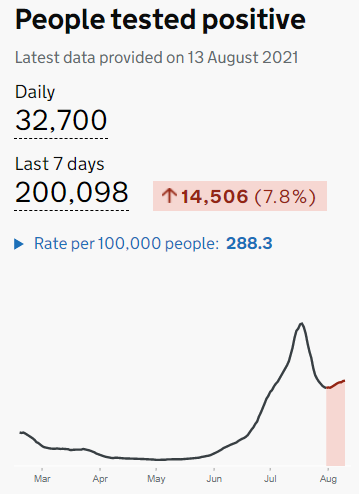
COVID sitrep: It’s clear to anyone following the news that we are expecting a very large wave of COVID-19 infections, driven by the new omicron variant. Very unwelcome news and we aren’t certain how well vaccination will protect us. Here’s what’s happening in NHS hospitals… 1/14 

The first thing to say is that when do a PCR test for COVID, we only get a positive or negative. The genotyping tests which tell us which variant take longer, and we aren't routinely sent them. So we don’t know in real time whether we are treating omicron or delta. 2/14
We are all looking at the graphs of new SARS CoV-2 ‘cases’. Like it or not, we face a huge wave of infections. Yesterday 93,000 people tested positive which is already well past the January 2020 peak of 81,000. 3/14 

Sceptics and non-sceptics alike, will ask whether this rise in infections is translating into rising admissions to NHS hospitals. We think so. Infections are rising fastest in London and we are beginning to see a very early rise in admissions.… 4/14 

….but in general, we are not yet seeing a wave of increased hospital admissions across the UK. Hospital admissions increase around 7-10 days after infections. So we know the wave is coming but it hasn’t hit us yet. The next two weeks will reveal a lot more. 5/14 

Looking just at Intensive Care, the number of COVID patients in ICU beds is currently around 900: almost one fifth of our national capacity - healthcare which is not available for other services such as major surgery. We don’t yet know how much these numbers will rise. 6/14 

Since July, NHS hospitals have been dealing with a lots of challenges: Very busy Emergency Departments, out of season epidemics of childhood infections, a huge backlog of patients waiting for surgery, and a moderate number of COVID patients as well…. 7/14
bbc.co.uk/news/health-59…
bbc.co.uk/news/health-59…
.…on top of these challenges we now know we will face a huge wave of omicron infections but we simply don’t yet know how many people will be sick enough to need hospital or ICU admission. We can hope for the best but we must plan for the worst. 8/14
The UK has one of the most vaccinated populations in the world. 812,000 people were vaccinated on Thursday alone. Good to see this report today suggesting vaccination will perform reasonably well against omicron but we still don’t know for sure. 9/14
bbc.co.uk/news/health-59…
bbc.co.uk/news/health-59…
Also on the plus side, we understand the disease really well. Clinical trials have delivered a range of new treatments. NHS escalation plans are tried and tested. Staff are well drilled, patient care more efficient. We have good supplies of drugs, PPE and ventilators. 10/14 

We also have reasons to worry. Existing staff shortages will get worse. Like everyone, NHS staff are tired of the pandemic. We are struggling to deliver ‘routine’ work such as surgery and cancer care. GP surgeries are very busy vaccinating us on top of their usual work. 11/14
This week’s @WHO map reminds us that COVID is a global problem. 545,000 new infections per day. Sharing drugs and vaccines with other countries is vital because none of us are safe until we’re all safe. 12/14 

Several doctor colleagues having difficult interactions with families who don't believe their loved one has COVID. This makes good patient care much harder. Please get your info from trusted sources eg @BBCNews. For doctors in the media, do they actually treat NHS patients? 13/14
The current NHS situation is difficult and will get worse. We’re not sure how much worse. All of our healthcare will be affected. Our individual actions are what keep COVID under control. So please stay vaccinated and keep up your good work with #HandsFaceSpace & fresh air💙14/14 

• • •
Missing some Tweet in this thread? You can try to
force a refresh




















